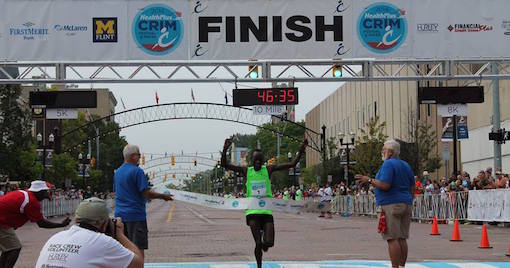Absopure
(un)Filtered

How to Train for a 10 Mile Run
This is a guest blog post from Joe Dimambro, assistant race and training program director for the Crim Fitness Foundation. Absopure is the official bottled water of the Crim Festival of Races.
The countdown to the 2015 HealthPlus Crim Festival Races has begun! In just a few short weeks, runners from across the world will take to the famed Flint, Michigan course, and spectators from the surrounding area will come to cheer on this year’s participants.
Since the first Crim Festival of Races was held 39 years ago, the event has expanded to include several races for people of all ages and fitness levels, including its highly-anticipated 10 Mile race, which attracts elite runners from around the world.
As any runner will tell you, preparation is key to preventing injuries, staying safe and finishing strong. No matter what distance you’re running, it’s important to start training well before race day. However, the longer distances you start to run, the more crucial training will become.
If you’re ready to kick things up a notch and sign up for your first 10 mile race, take heed of these important training tips from Joe Dimambro, assistant race and training program director for the Crim Fitness Foundation.
- Shift your focus from speed to endurance. Running long distances tests your physical and mental endurance. The thought of running 10 miles can be intimidating if you focus on the total distance. Make the thought of running 10 miles more manageable by breaking up the total distance into smaller segments and/or goals. Once you start hitting your mile marks, you’ll feel a sense of accomplishment and the finish line won’t seem so far away. Remember, slow and steady wins the race. If this is your first 10 mile race, focus on reaching the finish line, not how fast you’ll get there.
- Steadily increase the amount of miles you run or walk each week. If running is part of your regular routine, you should have a pretty good understanding of your fitness level and how many miles you’re used to running on a weekly basis. Make an effort to run or walk for an extended period of time each week. To start, designate one day a week toward longer runs. Aim to increase your total distance that day to 25% of your total weekly mileage. For example, if you’re running 30 miles a week, try to run 7.5 miles on your designated long distance day. Of course, this is not a hard and fast rule and varies for everyone depending on their fitness level and training plan. Consult your doctor before beginning a running program, and choose a plan that works best for you! And, make sure to incorporate at least one day of rest each week to allow your body to recover.
- Once you’ve started to build up your endurance and are comfortable running longer distances, spend time working on your goal race pace. Set aside some time within your training plan to do intervals or repeats on a track where you can focus on timing yourself based on your goal race pace. This will help your body learn what that pace feels like and make it easier to manage your pace on race day.
- Drink up! Drinking water and staying hydrated is important for peak athletic performance, so don’t wait until race day to start hydrating. What most people don’t realize is that proper hydration begins well before it’s time to lace up their shoes at the starting line. In the days and weeks leading up to your big race, make sure you’re drinking water consistently throughout the day and rehydrating after each training session. Use these pre-race hydration tips to make sure you’re taking advantage of water stations throughout the course on race day.
Here at the Crim, we have a great partnership with Absopure and are one of the few races that actually provide water for runners at the starting line, as well as water stations throughout the course and at the finish line. We also have outstanding groups of volunteers that have been coming back to the Crim year after year to help set up water stations and make sure the 15,000+ runners that participate in our race are staying adequately hydrated.
I think it’s important to note that anyone can develop a love and appreciation for running. It’s never too late to get into running or walking, and once you start it’s hard to stop. There are people of all ages and fitness levels that participate in the Crim Festival of Races, some who have been participating in the event since it was started 39 years ago. To help encourage members of our community to start running on a regular basis, we have developed a series structured adult training programs that are open to the public.
Have you participated in the Crim Festival of Races 10 Mile Run before? What training tips would you add to the list? Share your advice in the comments below.
About Crim Fitness Foundation: In August of 1977, Michigan House Speaker Bobby Crim and his assistant Lois Craig launched the first Bobby Crim 10 Mile Road Race. Little did they know that they were embarking on a journey that would change the City of Flint forever! In the 39 years since those first days as a race organization, the Crim Fitness Foundation has evolved into a highly regarded 501(c) 3 non-profit organization impacting the lives of thousands.





